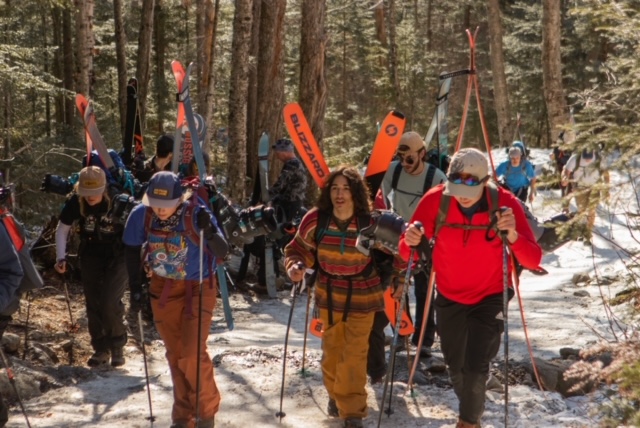Spring skiing at Tuckerman’s Ravine
Photo Courtesy of Sean Zimmerman
Students at Tuckerman’s Ravine located on Mt. Washington.
Tuckerman’s Ravine on Mount Washington in New Hampshire is the epitome of extreme skiing in the east. According to Time for Tuckerman, the spring season brings 3,000 hikers and skiers each day to see the prime beauty of this unique location.
People gather at the bottom of the bowl, listening to music, picnicking and hanging out with friends as people continue to ski down. The most extreme skiers launch off of cliffs, send backflips and jump over waterfalls.
Junior Camille Nichols is highly involved in Vermont’s ski scene, working with Ski The East, coaching for Mad River Glen’s junior freeride program and competing for UVM’s Freeskiing Team. Despite being from Colorado, Nichols prefers eastern ski culture.
“Spring skiing on the East Coast is a different breed,” Nichols said. “The window is short and most spring days are either icy beyond belief or feature a lot of dirt skiing. But when you finally get that one perfect spring skiing day, sun is out, the slopes are packed [and] everyone is wearing neon. It’s electric.”
Nichols’ favorite spring ski location in the east is Tuckerman’s Ravine.
“Up at Tuckerman’s Ravine, I have never witnessed such euphoric stupidity,” Nichols said. “Big sends are applauded, big falls even more.”
Several hours away from Tuckerman’s Ravine, the spring skiing culture presents itself in a different fashion at Killington Resort in Vermont.
Smoke rises from grills as music blasts from car speakers and people gather throughout the parking lot under the spring sunshine. The season brings out a variety of ski fashion—cool sunglasses, bright colored jackets and vintage one-piece snowsuits—to reveal the lively and vibrant nature of spring skiing.
In the terrain park, large groups of friends take laps together, slide rails and go off jumps.
First-year Alan Misura, avid snowboarder and officer for UVM’s Ski & Snowboard Club, admires spring skiing culture’s positive and welcoming energy.
“The real deal is East Coast slush days where everyone is hangin’ and partyin’ and just having good chill vibes,” he said. “It’s pretty tight.”
During spring, dirt and grass skiing is a popular way to experiment with the limited snow coverage.
“[In West Coast skiing], the goal is to avoid the rocks,” Nichols said. “The East Coast is exactly the opposite. Grass skiing, arguably the gnarliest part of spring skiing, is encouraged if not mandatory. You and all your buddies make a train [and] try to ski the grass lines around the snow.”
First-year Peter Nicholson admires the spring skiing culture in the east because people have fun regardless of limited snow coverage.
“Wicked chill vibes with dope ass skiers that’ll stomp just about anything that has snow within 100 yards of it,” Nicholson said on the culture. “None of that West Coast powder B.S. if the dirt’s packed tight, it’s all game.”
When there is sufficient coverage, however, the spring heat turns the snow to slush. Wet and soft, its unique texture defines spring skiing. Many skiers and riders often refer to slush as “corn.”
Siena Webb, sophomore and president of SSC, describes the slushy nature of spring snow: “Corn is a staple crop in agriculture production across the Midwest and an essential part of my radical Vermont spring skiing experience,” she said.
After the day is done on the mountain, many skiers like to tailgate in the parking lots.
“East Coast skiing in general is all about supporting each other and making even the worst days ones you will never forget,” Nichols said. “I feel so lucky to be a part of this community and highly encourage everyone to seek it out and spread the stoke.”







